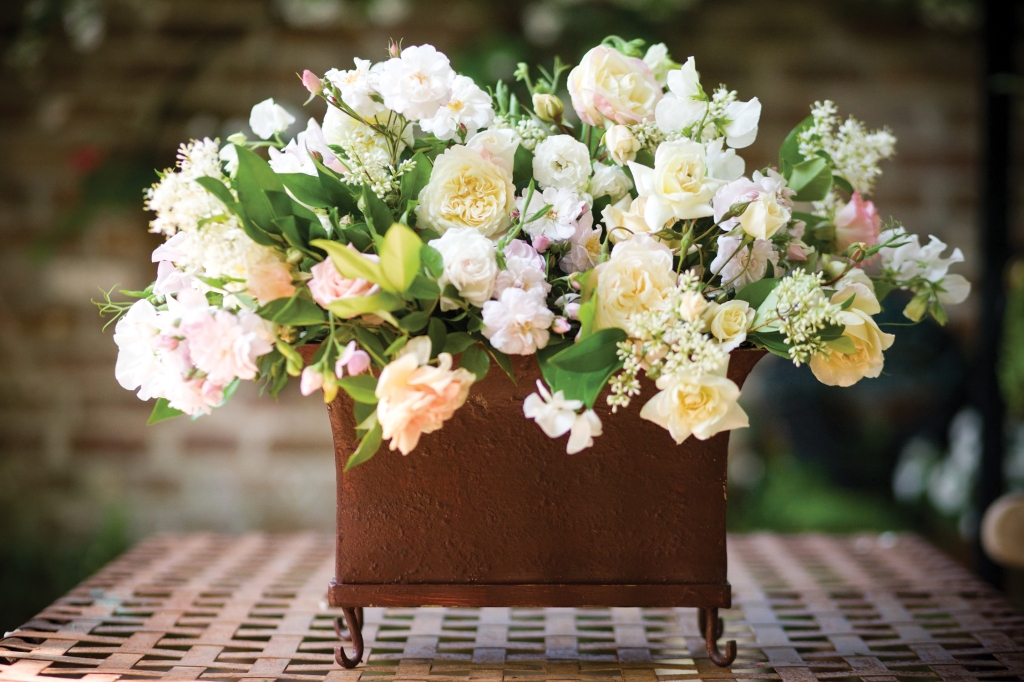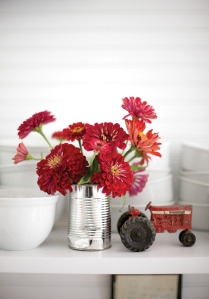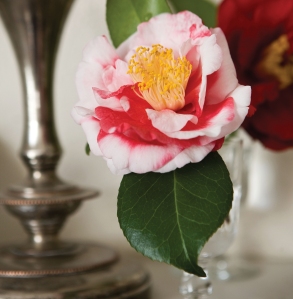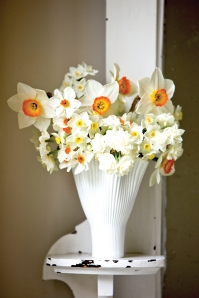
All photographs by Peter Frank Edwards from “Southern Bouquets” by Melissa Bigner with Heather Barrie. Reprinted with permission of Gibbs Smith.
Nothing brings a smile to people’s faces more easily than beautiful, fresh flowers. A fragrant bouquet welcoming guests to your inn is always a fantastic introduction to their planned getaway.
Those overflowing designed vases from the corner floral shop often exceed the average day-to-day B&B budget. With tips from professional floral designers, however, your own flower cut garden or even a batch of buds from a flower market or Costco can still WOW your guests.
It’s not difficult to search online and find a variety of floral arranging ideas and inspirational images. Pinterest has a bounty of beautiful bouquets. Martha Stewart, the DIY Goddess, also has an abundance of images on her website, in her magazines and her books, too. Real Simple’s website is also full of great, economical ideas.
 One great resource is a book titledSouthern Bouquets by Melissa Bigner with Heather Barrie. I had the honor of working with Melissa while she was promoting her book and found her tips to be extremely educational, fun and easy to follow. The images in her book, too, illustrate trends and truly unique vessel ideas.
One great resource is a book titledSouthern Bouquets by Melissa Bigner with Heather Barrie. I had the honor of working with Melissa while she was promoting her book and found her tips to be extremely educational, fun and easy to follow. The images in her book, too, illustrate trends and truly unique vessel ideas.
While researching floral design ideas, one theme was obvious – variety. That variety can be found in the different blooms you select, the variations in color themes, various floral heights, and variety in vase options.
When looking for a vessel for your floral arrangement try giving your traditional clear vases a break and look for something unusual. You might be able to find something from your kitchen cupboards like an oversized coffee cup, a pretty piece of colorful China (think Delft or even Fiesta Ware teacups), a wicker basket, galvanized metal bucket, a stoneware pitcher, a metal colander, or even a gravy boat.
You can also find simple vases in repurposed items like a cleaned-up tin soup can, old vintage soda bottles, mason jars, rusty tea tins, or even old spaghetti sauce jars. Enhanced with a little spray paint, some jute twine, ribbon or even glittery paint and you have a whole new go-to flower vase.
“If you’ve already gathered your flowers and greens, let them lead you to the right container and showcase spot,” says Melissa in Southern Bouquets. “For example, a handful of short-stemmed, laid-back zinnias might just beg for a Mason jar and a kitchen windowsill. On the other hand, you might want to decorate a specific mix of spaces: something for the entry, something for the mantel, something for the dinning table, something for the powder room.” In those cases, let the location dictate the bouquet. Remember, that if you are creating an arrangement for your breakfast table, you need to make sure people will be able to talk over the display.
“When it comes to matching containers with bouquets, almost anything goes. Yes, ensure that the materials work together visually, that the colors don’t clash and that the flowers – not the vessel – are the star, but beyond those guidelines, have fun.”
Below are some tips uncovered while researching floral arranging online and with Melissa’s help. These are just a sampling of ideas.
Tips for Creating the Perfect Bouquet
- To ensure tiny bud vases won’t topple under the weight of a bloom, place pebbles in the base of the vessel.
- A grid of clear cellophane tape spanning the wide mouth of the bowl supports the top-heavy flowers better than a frog would. Cut the stems short, and insert one or two flowers in each opening in the grid. Tuck fern clippings in last.
- Deep windowsills make a dream spot for bud vases, but know that sunlight speeds up their demise, and that dappled light for shade is best for cut flowers, unless you’re trying to force blooms open.

- Height matters. Make your bouquet taller than its container by about one and a half times. Also, make the width balance the height.
- Cluster a collection of smaller vessels to create the illusion of an abundant centerpiece.
- Add large, heavy flowers first turning the arrangement as you work to ensure even placement on all sides. Fill in with smaller, airier blooms, and leave enough space between the stems so individual flowers have room to shine. Include flowers with various shapes and stem lengths.
- When choosing bouquet bedfellows, look to what’s blooming at the same time.
- To support the stems in the low container, a frog is essential. A spiked one is good for the hydrangeas’ woody stems; bits of floral adhesive on the bottom of the frog keep it from shifting and scratching the pottery.
- Leave glossy evergreen camellia leaves on the stem to provide a colorful contrast to the soft texture and palette of petals.
- Allow a bouquet to be a little unruly and asymmetrical and it mimics the organic beauty of a naturally growing plant.
- Place bouquets in areas frequented by your guests – and even some unexpected areas – like powder rooms where the sight and scent will be a sweet surprise.
- Keep flowers away from sunlight and heating vents. Recut stems and add water often.
 Arranging Tips for Various Floral Varieties
Arranging Tips for Various Floral Varieties
Roses
- As soon as you cut roses, plunge their stems in water, and keep them in a cool, shaded area.
- Change water daily to prolong vase life.
- The shorter and thinner the stem, the lower the overall arrangement should be.
Azaleas
- Because azalea blooms are short-lived, cut them just as they start to bloom and display them immediately.
Daffodils
- Try not to get the sap on your skin, as it’s an irritant.
- Cut stems on an angle to help them best drink water.
- Change water and trim stems daily, as the sap thwarts longevity.
Camellias
- Cut blooms with as much of the woody stem attaches as possible and choose buds that are just barely cracking open to allow the petals to unfurl over the course of several days.
- When the blooms droop, trim stems away and float heads in a bowl of water.
Sunflowers
- Cut base of sunflowers on an angle so they can absorb water easily.
- Longer stems, larger heads, and numerous blooms on a single stem drink a lot of water – monitor levels to keep the plant hydrated.
- Cool, shady spots help perkiness.
Zinnias
- Remove loser leaves before using in bouquets to extend the life of the blooms and to avoid bacteria in the water.
Hydrangeas
- Cut mopheads after they have bloomed fully, while the petals are slightly tough and strong.
- Mash or split the ends of the woody stems to allow for better water absorption.

